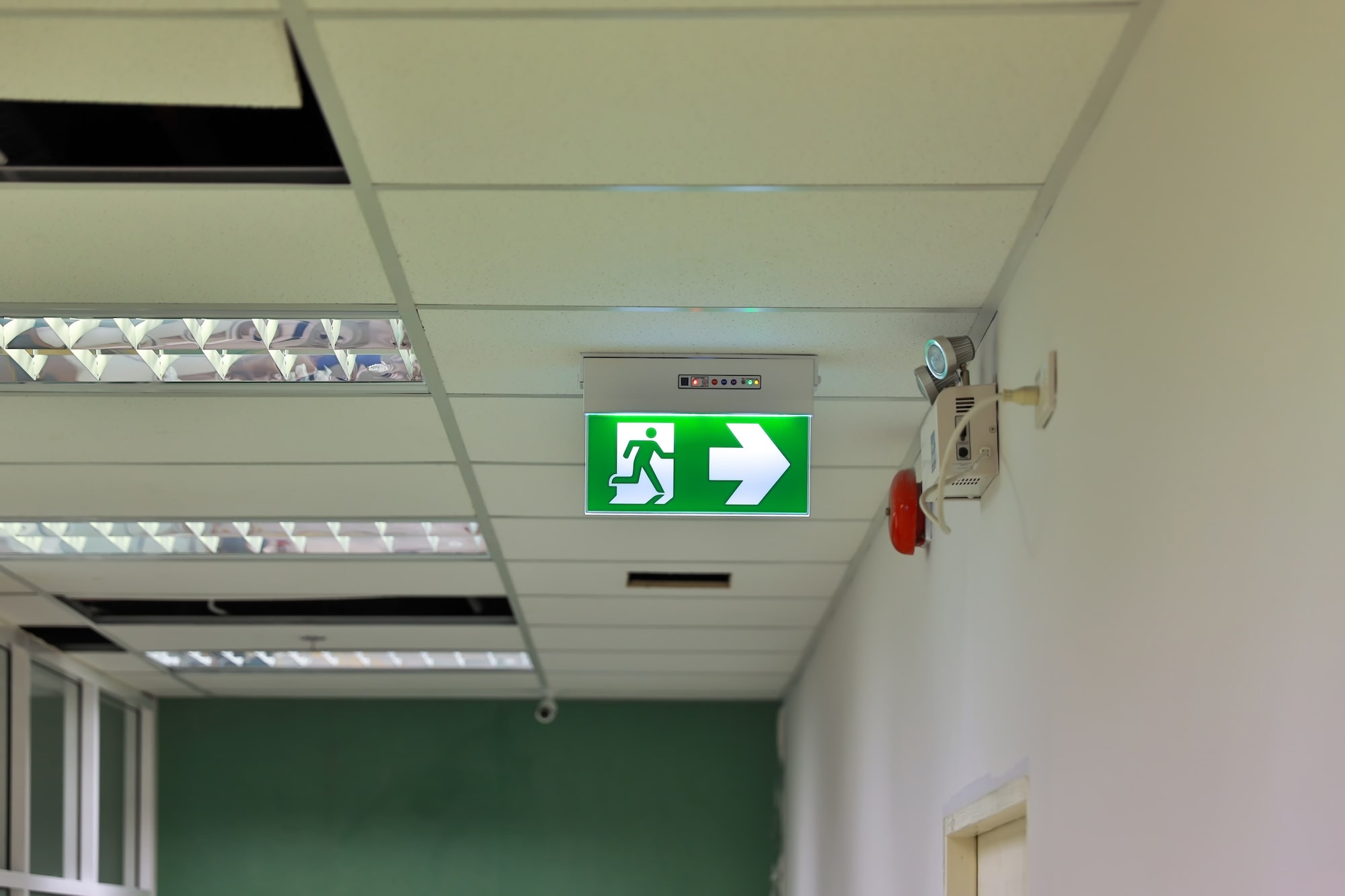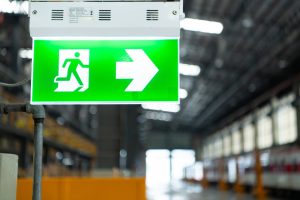
Emergency lighting plays a vital role in ensuring the safety of employees, customers, and visitors in any commercial property. In the event of a power outage or an emergency, these lights guide people safely out of the building, reducing the risk of panic and injury.
However, for emergency lighting to perform its crucial function when needed, it must be regularly tested and maintained to ensure it works flawlessly.
At Bolton Electrical Services, we specialise in the installation, testing, and maintenance of emergency lighting systems across Bolton and the North West, helping businesses stay compliant and safe.
Why Is Emergency Lighting Testing Important?
Ensuring Compliance with UK Regulations
In the UK, emergency lighting must adhere to strict legal requirements under BS 5266, which outlines the code of practice for emergency lighting in premises.
These regulations ensure that emergency lighting is installed, tested, and maintained to meet safety standards. Regular testing is essential to ensure your system remains compliant, as failure to do so can result in fines, penalties, and increased safety risks.
By keeping up with the legal requirements, you protect your business and avoid any legal complications that could arise from non-compliance.
Protecting Employees and Patrons in an Emergency
Emergency lighting is designed to provide illumination during power failures or fire emergencies, helping guide people safely out of a building.
In critical situations, such as a fire or blackout, functioning emergency lighting can be the difference between a smooth evacuation and chaos.
Ensuring that your emergency lighting system is regularly tested means that in the event of an emergency, you can trust that it will work as intended, giving staff and visitors the confidence they need to exit safely. We’ve seen first-hand how well-maintained systems can prevent accidents and save lives when things go wrong.
How Often Should Emergency Lighting Be Tested?
Monthly Emergency Light Test
Monthly emergency lighting tests are a crucial part of maintaining a fully functional system. These tests involve performing a brief functional check to ensure that all emergency lights come on when required.
During this test, we simulate a power failure by turning off the mains power to verify that the emergency lights automatically illuminate. While this test is straightforward, it’s important to document the results in an emergency lighting logbook, helping you maintain a clear record of compliance and ensuring that any faults are addressed promptly.
Regular monthly checks ensure that any issues are caught early before they pose a significant risk to safety.
Annual Emergency Light Test
In addition to monthly functional checks, a full-duration test is required annually to ensure your emergency lighting system operates at peak performance. This annual test involves switching off the mains power and leaving the emergency lights on for their full rated duration, usually three hours.
The purpose of this test is to confirm that the emergency lights can operate continuously for the necessary time without failure.
At Bolton Electrical Services, we recommend hiring qualified professionals to carry out this comprehensive test, ensuring that all components of the system are inspected, including the backup power supply and battery performance.
This in-depth testing helps to identify any underlying issues that may not be apparent during monthly checks.
Additional Interim Testing Requirements
Depending on the size and complexity of your building, additional interim tests may be required to ensure the continued reliability of your emergency lighting system. For larger commercial properties or those with complex layouts, it may be beneficial to conduct more frequent visual inspections or functionality tests between the monthly and annual checks.
These interim tests help ensure that potential issues are addressed before they become serious safety concerns. Regular interim checks allow for early detection of faults, helping you maintain an uninterrupted level of safety and compliance.

What Happens During an Emergency Lighting Test?
Monthly Emergency Lighting Checks
The monthly emergency lighting check is a quick but crucial functional test that ensures all emergency lights activate when needed.
During this process, we simulate a power outage by turning off the mains power, which triggers the emergency lighting system. The goal is to confirm that each light comes on and remains illuminated for the duration of the test.
While this test is brief, it’s essential for identifying any immediate issues that might affect performance in an actual emergency. Keeping a record of these checks helps you maintain compliance and ensures any faults are quickly addressed.
Annual Full-Duration Test
The annual emergency lighting test is more thorough and involves running the system for its full rated duration, typically three hours. This test ensures that the lights can operate continuously during an emergency, even under the stress of prolonged use.
Our team conducts a detailed inspection that includes checking the battery’s capacity to power the lights for the full duration, verifying that light output meets safety standards, and assessing the overall system integrity.
This full-duration test is essential for ensuring that your emergency lighting will function effectively when it’s needed most.
Who Is Responsible for Emergency Lighting Testing?
Responsibilities of Business Owners
In the UK, business owners and facility managers are legally responsible for ensuring that emergency lighting systems are regularly tested and properly maintained.
According to BS 5266, you must conduct both monthly functional tests and annual full-duration tests to comply with safety regulations. It’s crucial to keep detailed records of all tests, as these serve as evidence of compliance during health and safety inspections.
By working with a professional service like Bolton Electrical Services, you can ensure that your emergency lighting is always up to standard and that you’re meeting your legal obligations.
Using a Professional Service for Emergency Lighting Testing
While basic monthly checks can be carried out by in-house staff, it’s highly recommended to use a professional service for more detailed tests and ongoing maintenance. Hiring professionals ensures that your emergency lighting system complies with all regulations and works reliably in an emergency.
At Bolton Electrical Services, we have the expertise and experience to carry out both monthly and annual emergency lighting tests.
Our team ensures that all components of the system are thoroughly inspected, giving you peace of mind and confidence that your business remains compliant and safe.
Emergency Lighting Frequently Asked Questions (FAQ)
How often should emergency lighting be tested in the UK?
Emergency lighting in the UK should be tested on a regular basis to ensure it functions correctly in the event of an emergency. According to BS 5266, a brief functional test should be carried out monthly, where the mains power is temporarily turned off to check if the emergency lights activate.
Additionally, an annual full-duration test is required, where the emergency lights are run for their full rated duration (typically three hours) to confirm they can operate for the necessary time in an emergency.
What is involved in a full-duration emergency lighting test?
A full-duration emergency lighting test is a comprehensive check of the system’s ability to function under emergency conditions. During this test, the mains power is switched off, and the emergency lights are left on for their full rated duration, usually three hours.
This ensures that the backup power system, such as batteries or generators, can sustain the lighting for the required period.
The test also includes checking the performance of individual lights, inspecting the system’s integrity, and ensuring that all emergency lights operate as intended.
What happens if emergency lighting fails a test?
If emergency lighting fails a test, immediate corrective action is needed to ensure the system is compliant and fully operational. This may involve replacing faulty bulbs, addressing wiring issues, or servicing the backup power supply.
Once the issue is identified and repaired, the lighting system should be retested to verify that the problem has been resolved and that the system is ready for use in an emergency.
Can I test my own emergency lighting system?
While on-site personnel can perform basic monthly checks to ensure the lights activate, it’s recommended that the annual full-duration test be conducted by a qualified professional.
This ensures that the test meets the legal requirements set out in BS 5266 and that any technical issues are properly addressed. Professional testing helps ensure compliance with UK regulations and guarantees that your emergency lighting system will function correctly in critical situations.
